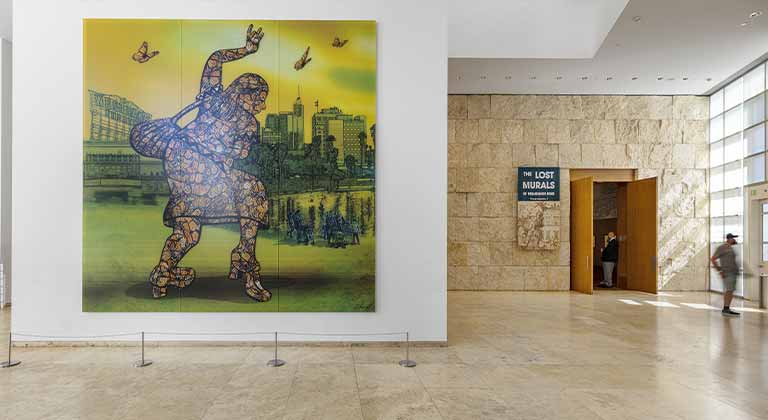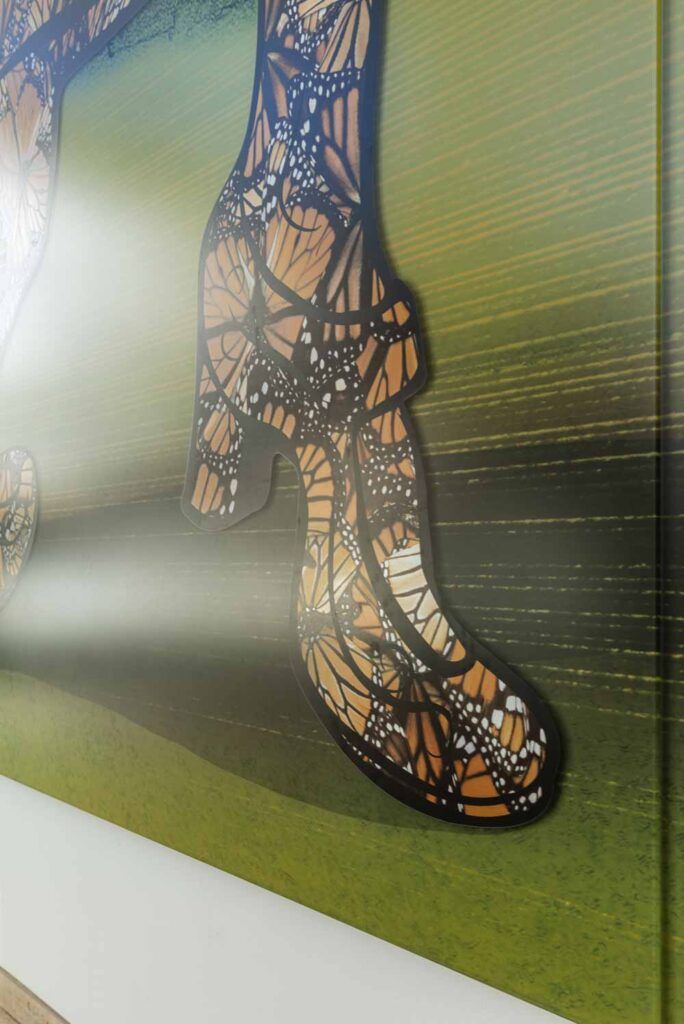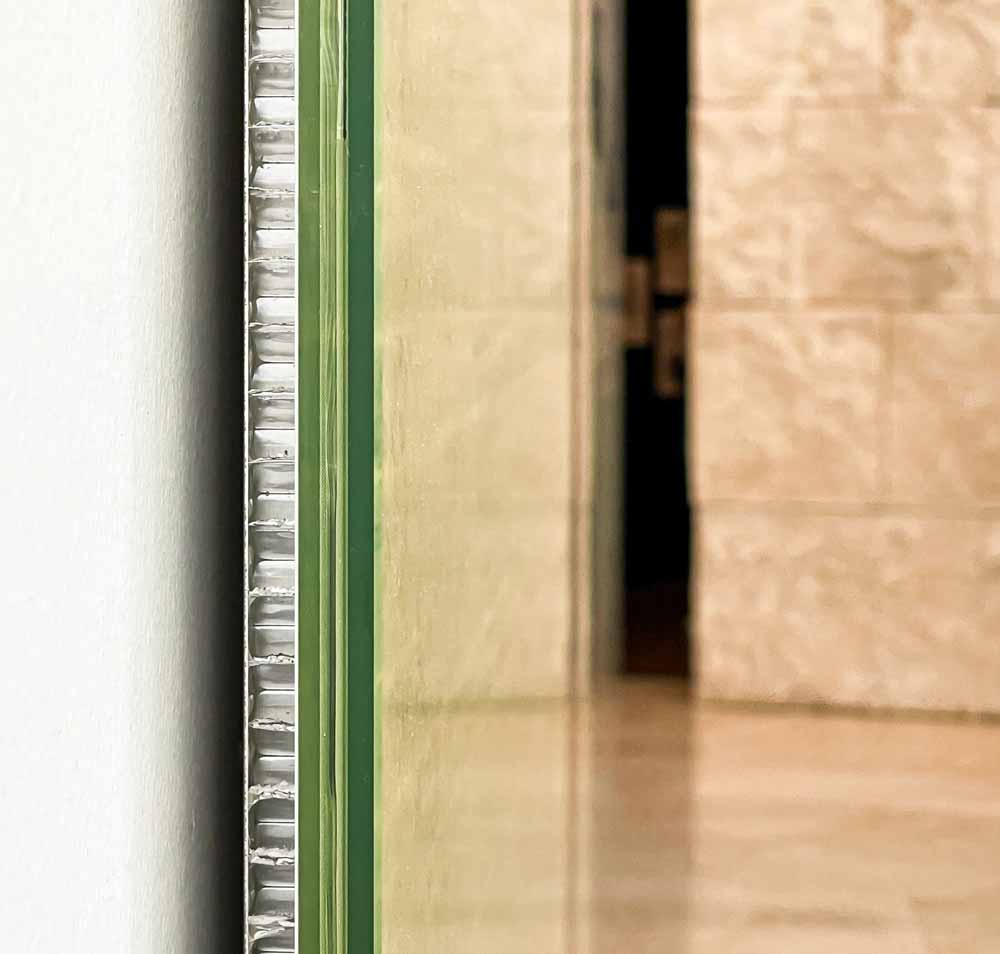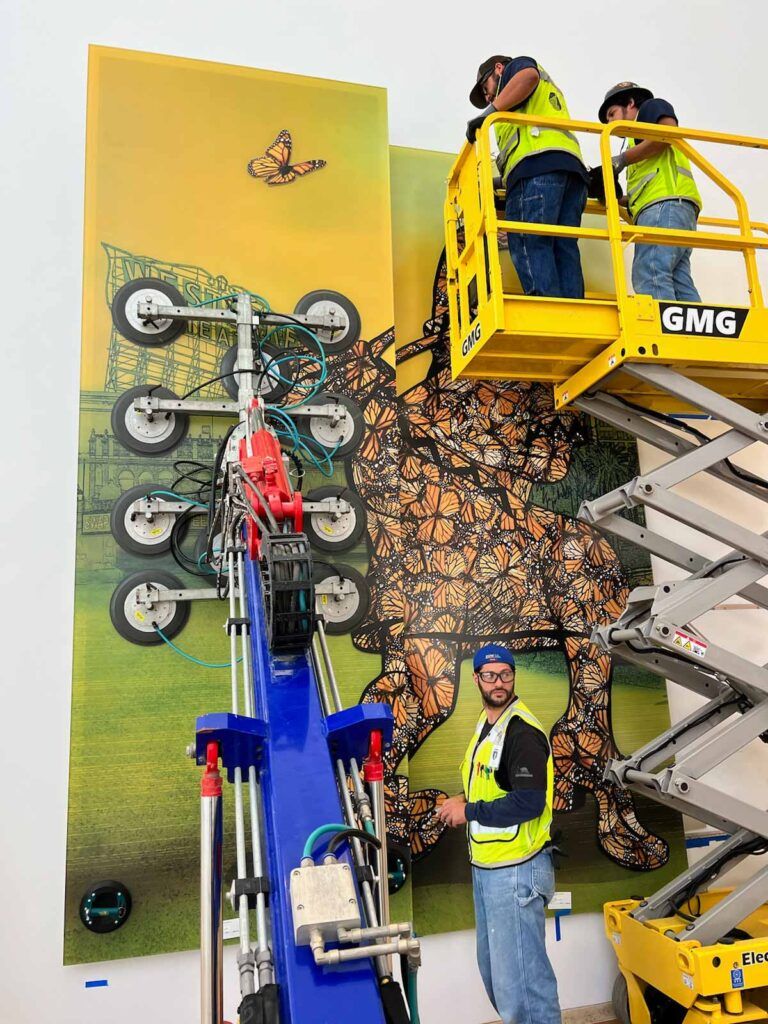
World-class institutions like the Getty Center demand flawless execution of services when installing exhibits of valuable fine art. When the medium is glass instead of oil paint, wood, or paper, our expert team of glaziers provide truly masterful installations worthy of this renowned museum.
A current exhibit on murals at the Getty Center features the artwork of renowned muralist, Judy Baca. Baca is perhaps best known for her 1976 work entitled “The Great Wall of Los Angeles.” At 1,000 feet long and located in the San Fernando Valley (in the Tujunga wash), it is hailed as the world’s longest mural and depicts the history of California “as seen through the eyes of women and minorities.” Baca is also known for her famous Downtown Los Angeles landmark, “Hitting the Wall: Women in the Marathon,” another mural highlighted in this exhibit, and which was one of ten murals commissioned by the City for the 1984 Olympics.
The Social and Public Art Resource Center (SPARC) enlisted Giroux Glass to create and install an unusual portion of this exhibit, one that is significantly different from Baca’s usual medium. Three 800-pound, laminated, custom-graphic glass panels, once installed by Giroux Glass, comprise “”La Salsera,” (The Salsa Dancer) a composite art piece that measures 15’ wide x 14’ high. It depicts a dancing woman in front of MacArthur Park, on her way to catching a bus on Wilshire Blvd. in Los Angeles. She is filled with monarch butterflies, a symbol of immigrants and migrations.

The preparation and planning involved in getting to the point of installation took much more time than the actual installation. It was a unique challenge for Pulp Studio to reproduce the art onto the 1-1/16” glass panels. The innovative technique to create the mural involved printing a digitally created image on glass with finely ground glass frit. These mineral colors melded with the glass upon firing. Replicating the intricate design required close collaboration between the artist and Pulp Studio, to decide where to separate the art into the three panels, and to reproduce the colors and design to the artist’s approval. The final graphic separated the design for printing onto both the back and the front of the glass: one with the background design, the other with the woman in the foreground. The result? The interesting illusion of the piece being three-dimensional, and a long-lasting mural with colors less likely to fade from exposure to sunlight. According to the Getty Center, La Salsera is the first direct-to-glass digital mural that incorporates two layers of design.
Giroux Glass also encountered some unusual challenges in the installation of this exhibit:
Timing:
This project was completed on an accelerated timeline to meet the target date of the exhibit’s opening on May 31. Pulp Studio successfully completed the fabrication in just three weeks, while Giroux Glass checked and double-checked that everything on order was correct. With the hard deadline of the looming exhibit start date, there was no room for error or time for replacements; everything had to be right the first time.
With the museum being closed only one day each week, Mondays were the one day and opportunity for Giroux to accomplish as much as possible. Project Manager, Abdul Aziz-Zoua, spent one Monday scoping the museum grounds to determine logistics. On another Monday, the crew prepped the wall for the installation. Giroux installed the mural’s glass on Monday, May 23, one week before the exhibit start date, and with the crew returning the next morning before the museum opened to complete final touches.
Structural Engineering:
Giroux Glass worked with Najjarine Structures to provide the structural engineering for the project. It was critical that once installed, there should be minimal seams between each of the panels, to prevent the appearance of any space or separation between the panels. Judy Baca’s creative vision was for the three panels to appear as one solid piece, and this clearly was accomplished in a colorful and colossal manner.
Transporting:
Once off the truck, moving three fragile panels that weigh 800 pounds each and measure 5’ wide x 14’ long presented a significant challenge, especially for a team that was very aware that if one unit were to become damaged in any way, there would not be enough time to fabricate a replacement. Despite the transporting of glass taking place on a day when the museum was closed, there were still many other workers on site. The museum grounds are spacious: 24 acres in total, so the distance from the freight elevator to the intended gallery wall was significant. It took a team of five glaziers and the use of a dry wall dolly, to navigate the chosen path of fewest obstacles and shortest distance between other people, railings, and a score of other obstacles.
Hanging:
Each panel was transported along its precarious path, then hung on the gallery wall before returning the dolly to the truck to repeat the process all over again with the next panel.

Pulp Studio provided their patented system, Light Glass Technology™ (“LGT”) – a system that combines an aluminum honeycomb core laminated to a series of z-clips, to attach the panels to the wall. Getting this installed perfectly — and with minimal space between each panel — was the result of ensuring that all the measurements and materials were checked repeatedly and right for the project.

The ultimate compliment came from Carlos Rogel, Executive Director for SPARC, “Abdul (Aziz-Zoua), you were a fantastic partner. Thank you so much for everything you did behind the scenes as well to expedite the process. Also — great install team. Super courteous and considerate. I look forward to working with you again in the future.”
It’s feedback like this that drives the Giroux team to go the extra mile, every time. The talented glaziers who worked on this project were: Chris Duren, Eddy Lopez, Oscar Garcia, Miguel Del Real, and Karlo Amireh. The project was managed by Abdul Aziz-Zoua, PMP and LEED Certified, and our very special thanks to our partner, Cathy Yamasaki, at Pulp Studio.